Design and Kinematic and Dynamic Analysis Simulation of a Biomimetic Parallel Mechanism for Lumbar Rehabilitation Exoskeleton
Abstract
1. Introduction
2. Biomimetic Design of Flexible Exoskeleton for Lumbar Rehabilitation
2.1. Analysis of the Mechanism of Human Lumbar Spine Movement
2.2. Analysis of Lumbar Spine Loading and Decompression Mechanisms
2.3. Lumbar Rehabilitation Flexible Exoskeleton Bionic Mechanism Configuration
2.4. Degrees of Freedom Analysis of a BPM for Lumbar Rehabilitation
3. Kinematics Analysis of Flexible Exoskeleton for Lumbar Spine Rehabilitation
3.1. Kinematic Position Inverse Solution of BPMs
3.2. Kinematic Position Solution of BPMs
3.3. Numerical Simulation Verification of Kinematic Models
4. Dynamic Analysis of Flexible Exoskeleton for Lumbar Rehabilitation
4.1. Kinematic Analysis of Bionic Parallel Mechanisms: Velocity and Acceleration
4.2. Dynamic Model of Bionic Parallel Mechanism
4.3. Simulation Verification of the Dynamic Model
- (1)
- MATLAB Numerical Calculation of Dynamic Model
- (2)
- ADAMS Dynamic Model Simulation
4.4. Dynamic Parameter Estimation of Driving Pushrods
5. Structural Design and Prototype Development of Lumbar Rehabilitation Flexible Exoskeleton
5.1. Experiment on Maximum Daily Range of Motion of the Human Lumbar Region
5.2. Structural Design of LRFE
5.3. Fabrication of the Lumbar Rehabilitation Flexible Exoskeleton Prototype
6. Workspace Analysis and Maximum Range of Motion Test of Lumbar Rehabilitation Flexible Exoskeleton
6.1. Workspace Analysis of Bionic Parallel Mechanism
6.2. Maximum Range of Motion Test Experiment for Prototype
7. Conclusions
Author Contributions
Funding
Data Availability Statement
Conflicts of Interest
References
- James, S.L.; Afshin, A.; Agesa, K.M.; Alam, T.; Ballesteros, K.E.; Blacker, B.F.; Briant, P.S.; Carter, A.; Cercy, K.M.; Cromwell, E.A. Global, regional, and national incidence, prevalence, and years lived with disability for 354 diseases and injuries for 195 countries and territories, 1990–2017: A systematic analysis for the Global Burden of Disease Study 2017. Lancet 2018, 392, 1789–1858. [Google Scholar] [CrossRef] [PubMed]
- Bernstein, I.A.; Malik, Q.; Carville, S.; Ward, S. Low back pain and sciatica: Summary of NICE guidance. BMJ 2017, 356, i6748. [Google Scholar] [CrossRef] [PubMed]
- Talaty, M.; Esquenazi, A.; Briceno, J.E. Differentiating ability in users of the ReWalk™ powered exoskeleton: An analysis of walking kinematics. In Proceedings of the 2013 IEEE International Conference on Rehabilitation Robotics (ICORR), Seattle, WA, USA, 20–24 June 2013; p. 6650469. [Google Scholar]
- Jezernik, S.; Colombo, G.; Morari, M. Automatic gait-pattern adaptation algorithms for rehabilitation with a 4-DOF robotic orthosis. IEEE Trans. Robot. Autom. 2004, 20, 574–582. [Google Scholar] [CrossRef]
- Huang, J.; Tu, X.; He, J. Design and evaluation of the RUPERT wearable upper extremity exoskeleton robot for clinical and in-home therapies. IEEE Trans. Syst. Man Cybern. Syst. 2015, 46, 1–10. [Google Scholar] [CrossRef]
- Pransky, J. The Pransky interview: Russ Angold, co-founder and president of Eksotm Labs. Ind. Robot. Int. J. 2014, 41, 329–334. [Google Scholar] [CrossRef]
- Toxiri, S.; Calanca, A.; Ortiz, J.; Fiorini, P.; Caldwell, D.G. A Parallel-Elastic Actuator for a Torque-Controlled Back-Support Exoskeleton. IEEE Robot. Autom. Lett. 2018, 3, 492–499. [Google Scholar] [CrossRef]
- Toxiri, S.; Ortiz, J.; Caldwell, D.G. Assistive Strategies for a Back Support Exoskeleton: Experimental Evaluation. In Advances in Service and Industrial Robotics. RAAD 2017. Mechanisms and Machine Science; Ferraresi, C., Quaglia, G., Eds.; Springer: Cham, Switzerland, 2018; Volume 49. [Google Scholar]
- Harant, M.; Sreenivasa, M.; Millard, M.; Šarabon, N.; Mombaur, K. Parameter optimization for passive spinal exoskeletons based on experimental data and optimal control. In Proceedings of the 2017 IEEE-RAS 17th International Conference on Humanoid Robotics (Humanoids), Birmingham, UK, 15–17 November 2017. [Google Scholar]
- Kawamoto, H.; Lee, S.; Kanbe, S.; Sankai, Y. Power assist method for HAL-3 using EMG-based feedback controller. In Proceedings of the 2003 IEEE International Conference on Systems, Man and Cybernetics. Conference Theme-System Security and Assurance (Cat. No. 03CH37483), Washington, DC, USA, 8 October 2003; Volume 2, pp. 1648–1653. [Google Scholar]
- Suzuki, K.; Mito, G.; Kawamoto, H.; Hasegawa, Y.; Sankai, Y. Intention-based walking support for paraplegia patients with Robot Suit HAL. Adv. Robot. 2007, 21, 1441–1469. [Google Scholar] [CrossRef]
- Activelink, P. AWN-03. 2020. Available online: https://news.panasonic.com/global/stories/2016/44969.html (accessed on 14 May 2020).
- FINGAS JON. Panasonic Shows How Its Robotic Suits Ease Your Burden. Available online: https://www.engadget.com/2016/03/21/panasonic-robotic-suits/ (accessed on 21 March 2016).
- Bo’an Medical Lumbar Traction Device. Available online: http://www.nbboan.com/cn/index.php (accessed on 21 October 2022).
- Du, M.; Wang, Q.; Zhu, L.; Liu, Z.; Shi, L.; Fang, Y.; Gu, Y. Development of a Control System for a Lower Limb Exoskeleton Rehabilitation Robot for Stroke Patients with Standing Instability. In Proceedings of the 2024 IEEE International Conference on Cognitive Computing and Complex Data (ICCD), Qinzhou, China, 28–30 September 2024; pp. 277–280. [Google Scholar] [CrossRef]
- Wang, L.; Xu, L.; Wang, Z.; Ye, L.; Mei, H. Design and Analysis of an Exoskeleton Robotic Actuator for Lumbar Spine Assisted Rehabilitation. Intelligent Robotics and Applications. In International Conference on Intelligent Robotics and Applications 2024; Lan, X., Mei, X., Jiang, C., Zhao, F., Tian, Z., Eds.; Lecture Notes in Computer Science; Springer: Singapore, 2025; Volume 15203. [Google Scholar] [CrossRef]
- Jeong, K.W.; Jeong, S.J.; Bae, K.T.; Kim, B.J. Analysis of Questionary After the Application of the Air Inflated Lumber Corset (Disk Dr.). Available online: https://advanced.onlinelibrary.wiley.com/doi/abs/10.1002/adma.201803388 (accessed on 1 August 2025).
- Karpiński, R.; Jaworski, U. Biomechanics of the human spine. J. Technol. Exploit. Mech. Eng. 2017, 3, 8–12. [Google Scholar] [CrossRef]
- Yue, S. Rapid Traction of the Lumbar Spine. Chin. J. Rehabil. Med. 2005, 20, 374–375. [Google Scholar]
- Panjabi, M.M.; Oxland, T.R.; Yamamoto, I.; Crisco, J.J. Mechanical behavior of the human lumbar and lumbosacral spine as shown by three-dimensional load-displacement curves. J. Bone Jt. Surg. Am. 1994, 76, 413–424. [Google Scholar] [CrossRef] [PubMed]
- Wilke, H.; Neef, P.; Caimi, M.; Hoogland, T.; Claes, L.E. New in vivo measurements of pressures in the intervertebral disc in daily life. Spine 1999, 24, 755–762. [Google Scholar] [CrossRef] [PubMed]
- Örtengren, R.; Dersson, G.B.J.; Nachemson, A.L. Studies of relationships between lumbar disc pressure, myoelectric back muscle activity, and intra-abdominal intragastric pressure. Spine 1981, 6, 98–103. [Google Scholar] [CrossRef] [PubMed]
- Lantz, S.A.; Schultz, A.B. Lumbar spine orthosis wearing. II. Effect on trunk muscle myoelectric activity. Spine 1986, 11, 838–842. [Google Scholar] [CrossRef] [PubMed]
- Agabegi, S.S.; Asghar, F.A.; Herkowitz, H.N. Spinal orthoses. J. Am. Acad. Orthop. Surg. 2010, 18, 657–667. [Google Scholar] [CrossRef] [PubMed]
- Hu, B.; Wang, A.; Li, Z.; Gao, J.; Shi, D.; Zhang, K. Kinematic and dynamic analysis of a motion seat based on a novel 4-UPS+PSPR parallel mechanism. J. Yanshan Univ. 2018, 42, 11–21+28. [Google Scholar]
- Kang, J.; Jia, Y.; Yuan, Y. Structural Design and Kinematic Analysis of Wearable Weight-Bearing Exoskeletons. Sci. Technol. Outlook 2017, 27, 298. [Google Scholar]
- Geng, M.; Bian, H.; Liu, C.; Li, X. Dynamical Modeling and Analysis of a 4UPS/UPR Parallel Mechanism Based on Rotor Torque. Comb. Mach. Tools Autom. Mach. Technol. 2018, 5, 42–46. [Google Scholar]
- Hu, B. Theoretical Research on Constraint-Based/Moment-Based Parallel Mechanisms and Series-Parallel Mechanisms with Few Degrees of Freedom. Ph.D. Thesis, Yanshan University, Qinhuangdao, China, 2010. [Google Scholar]

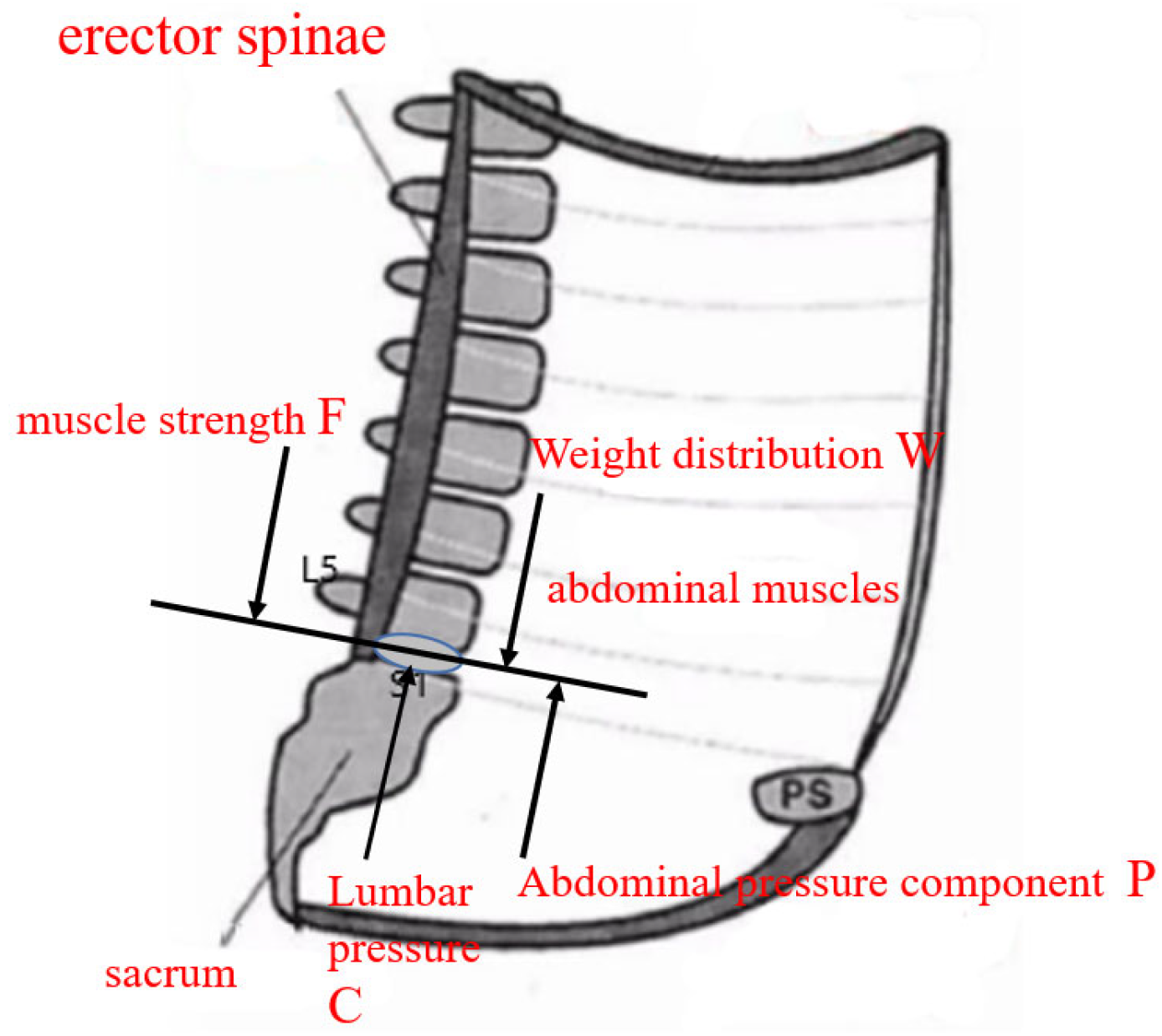
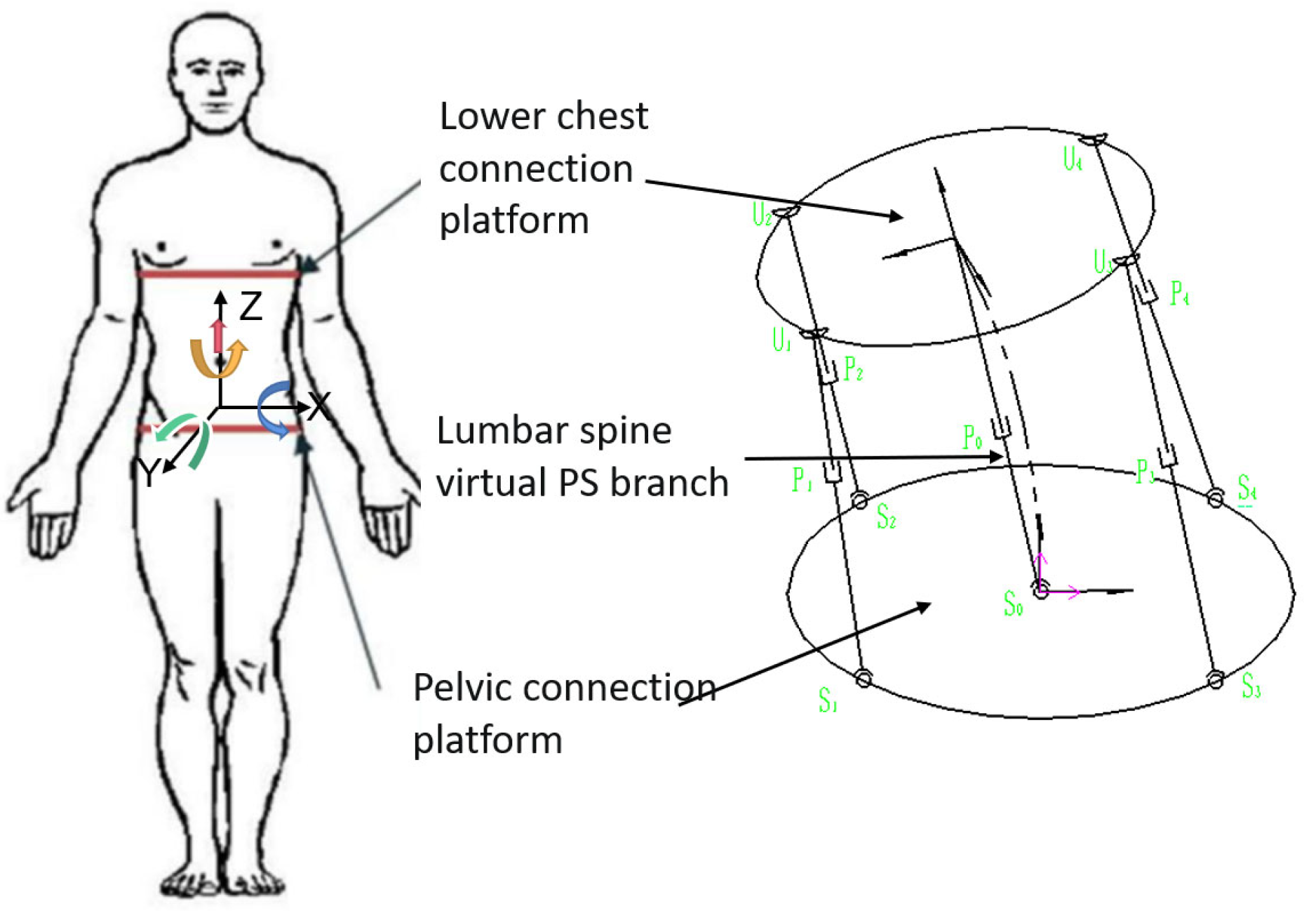
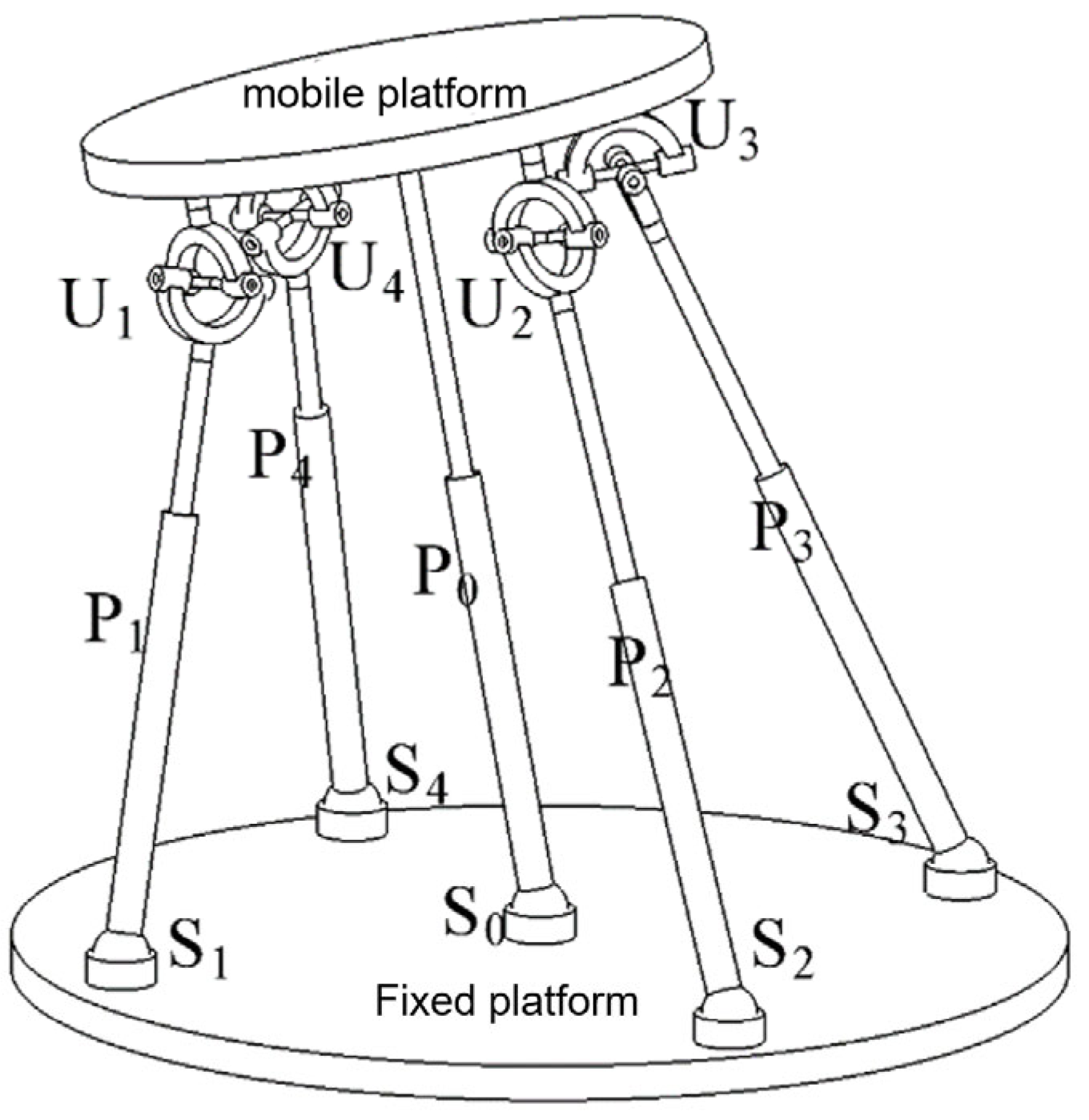
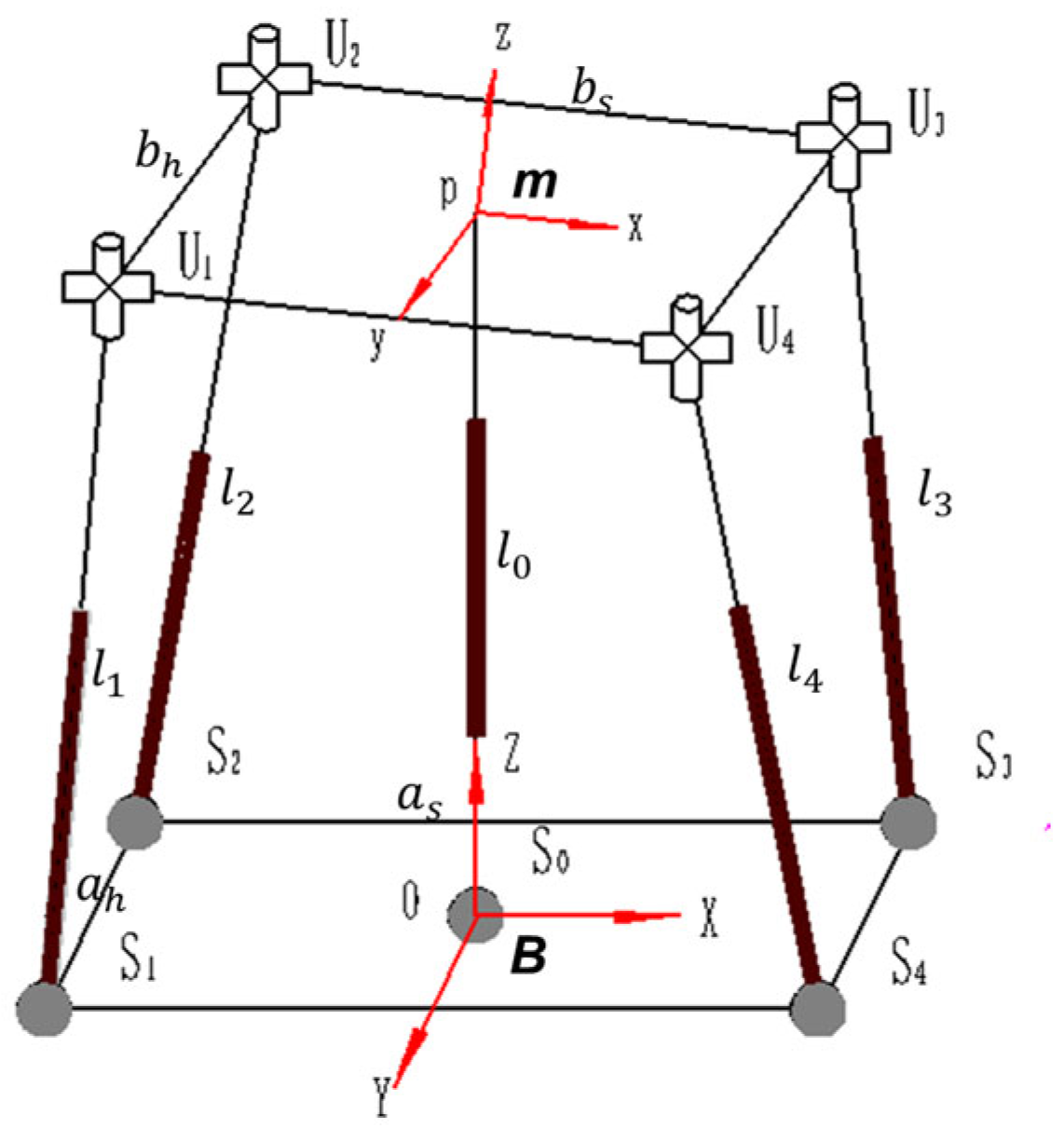
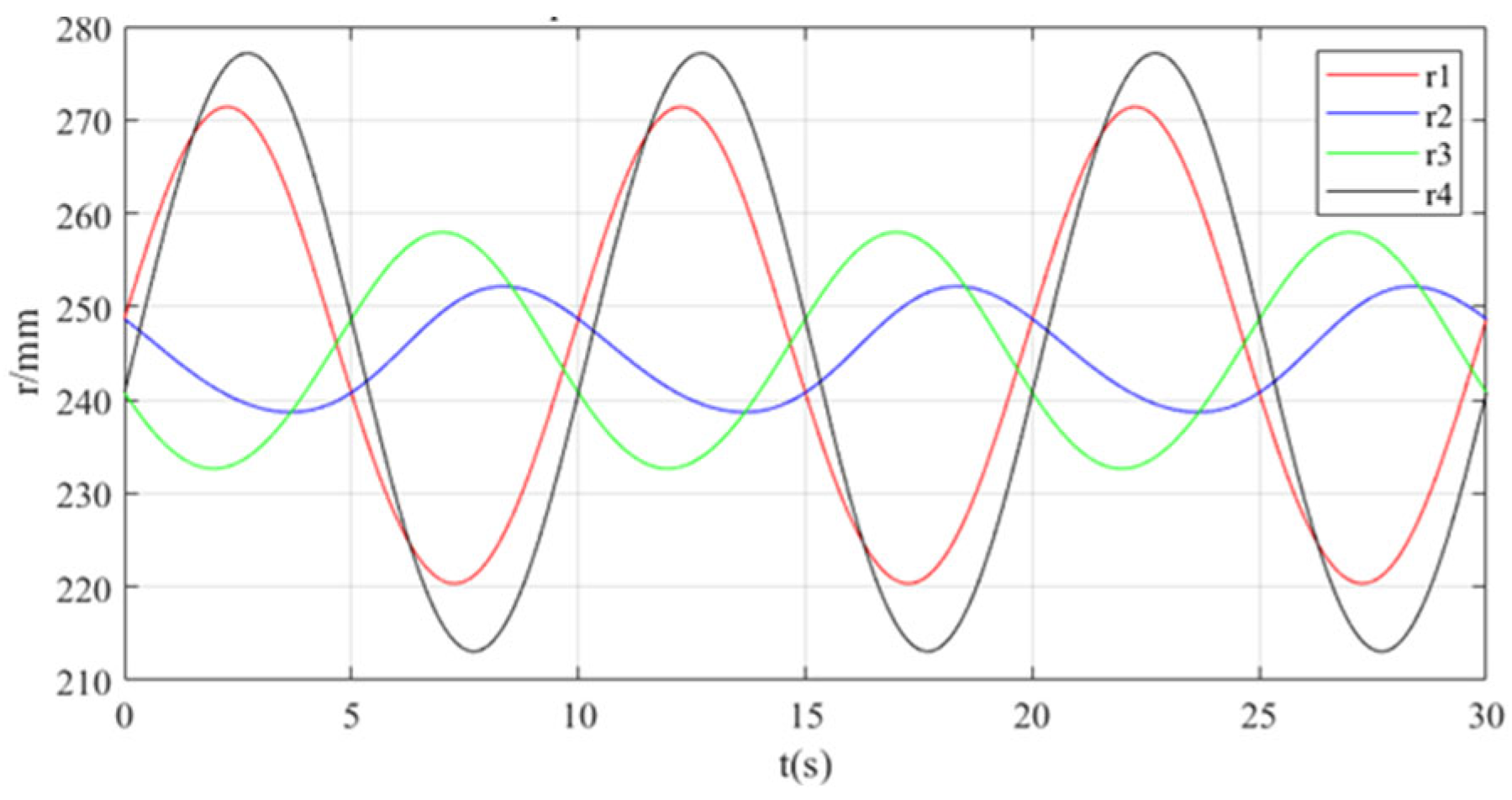

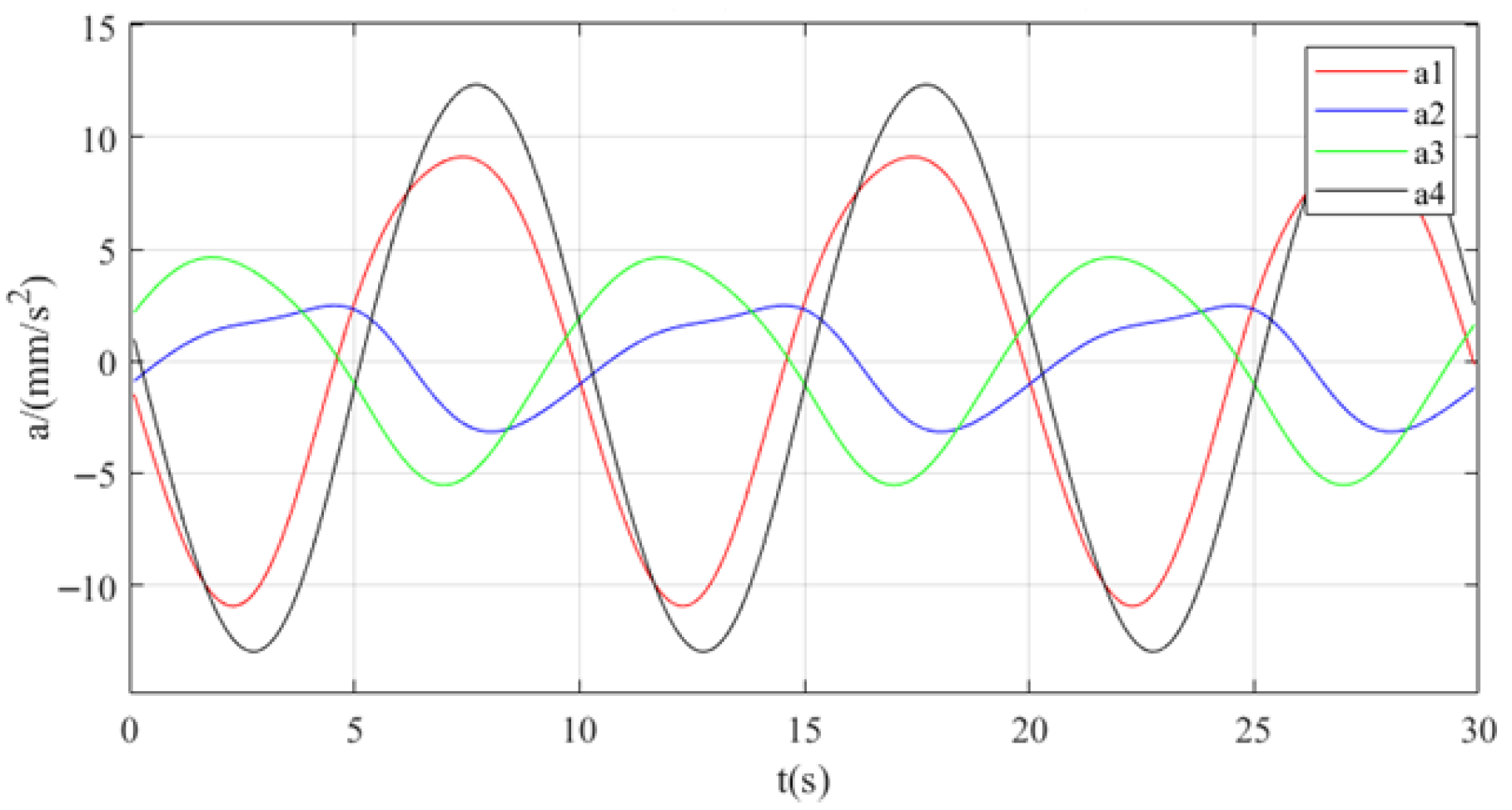

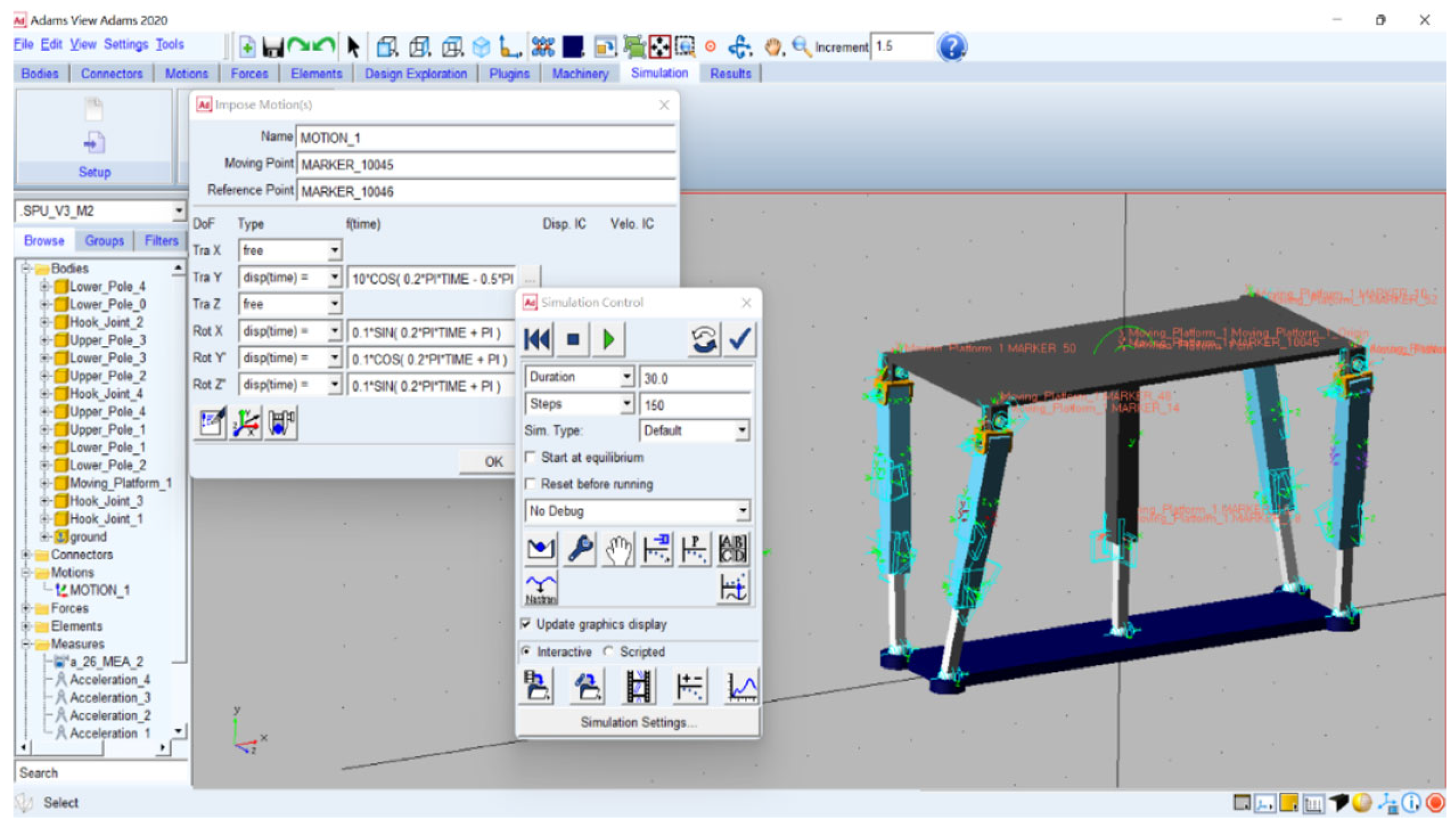

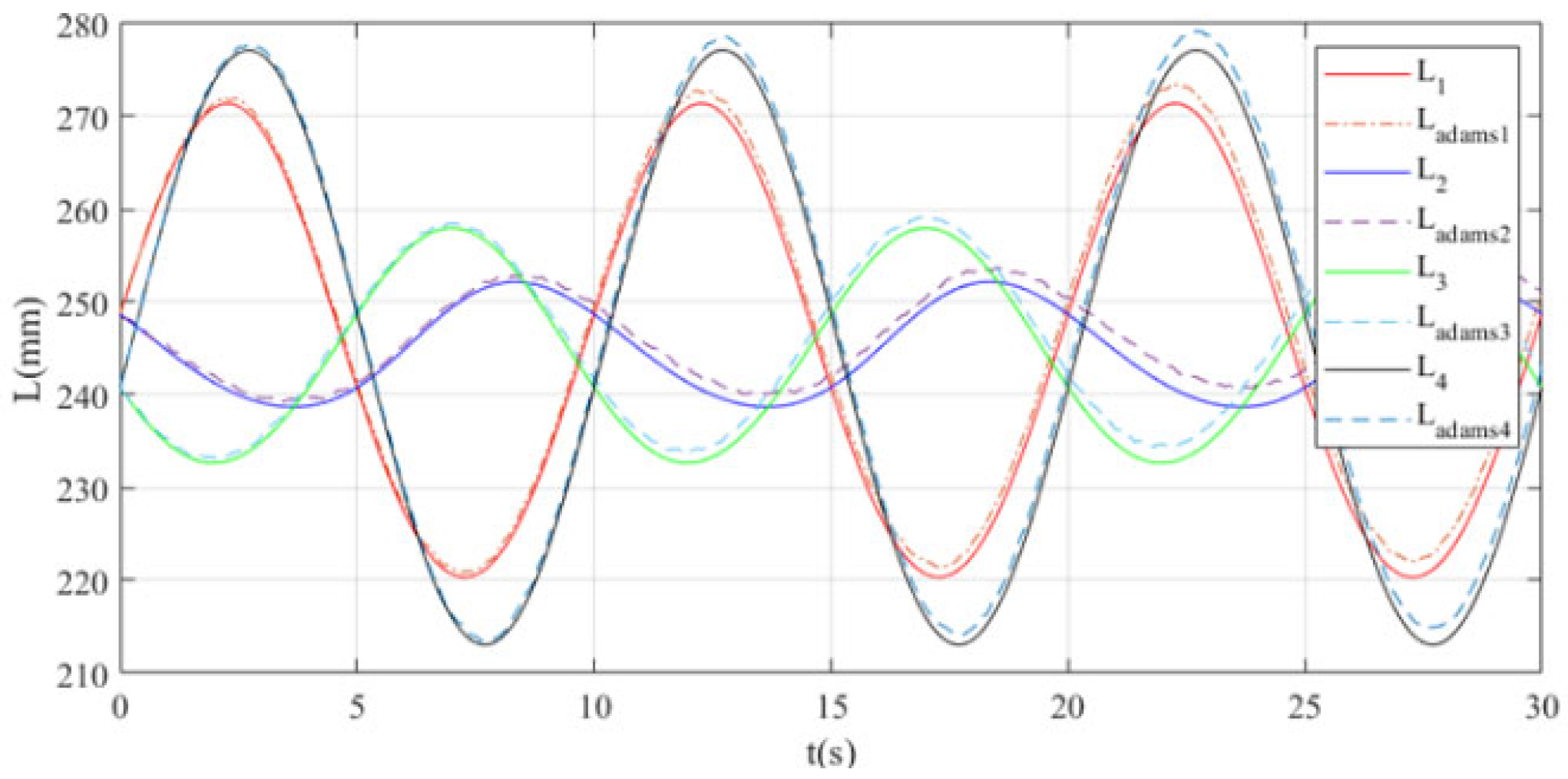

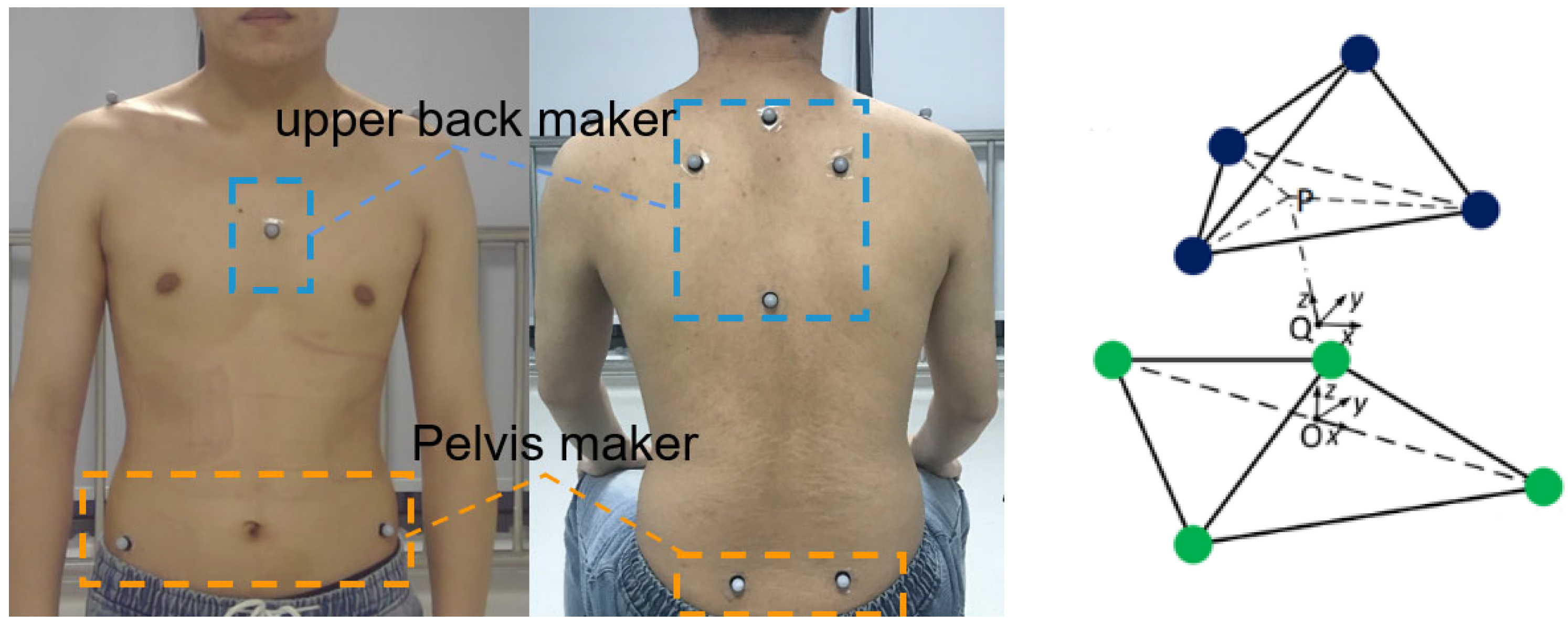


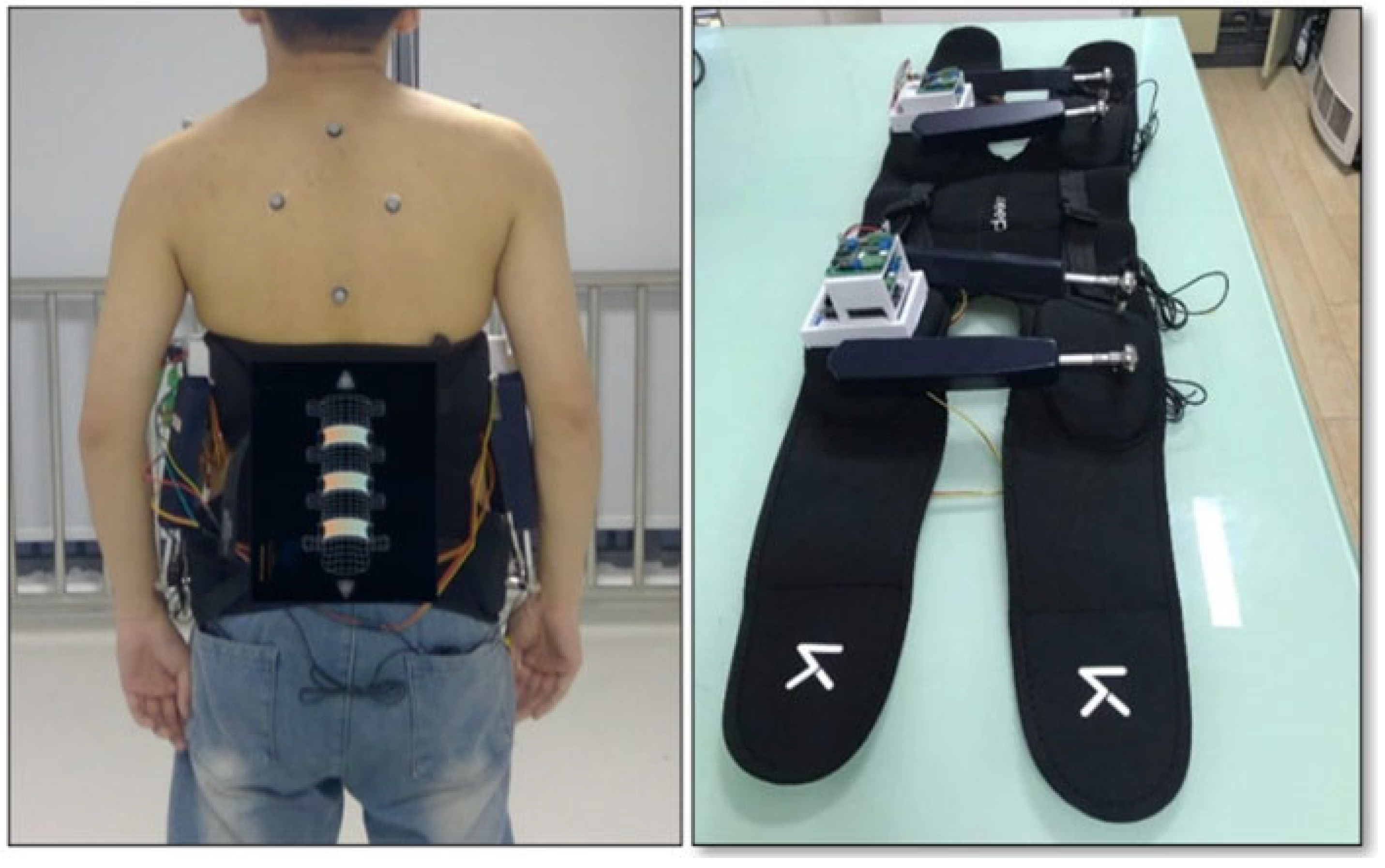

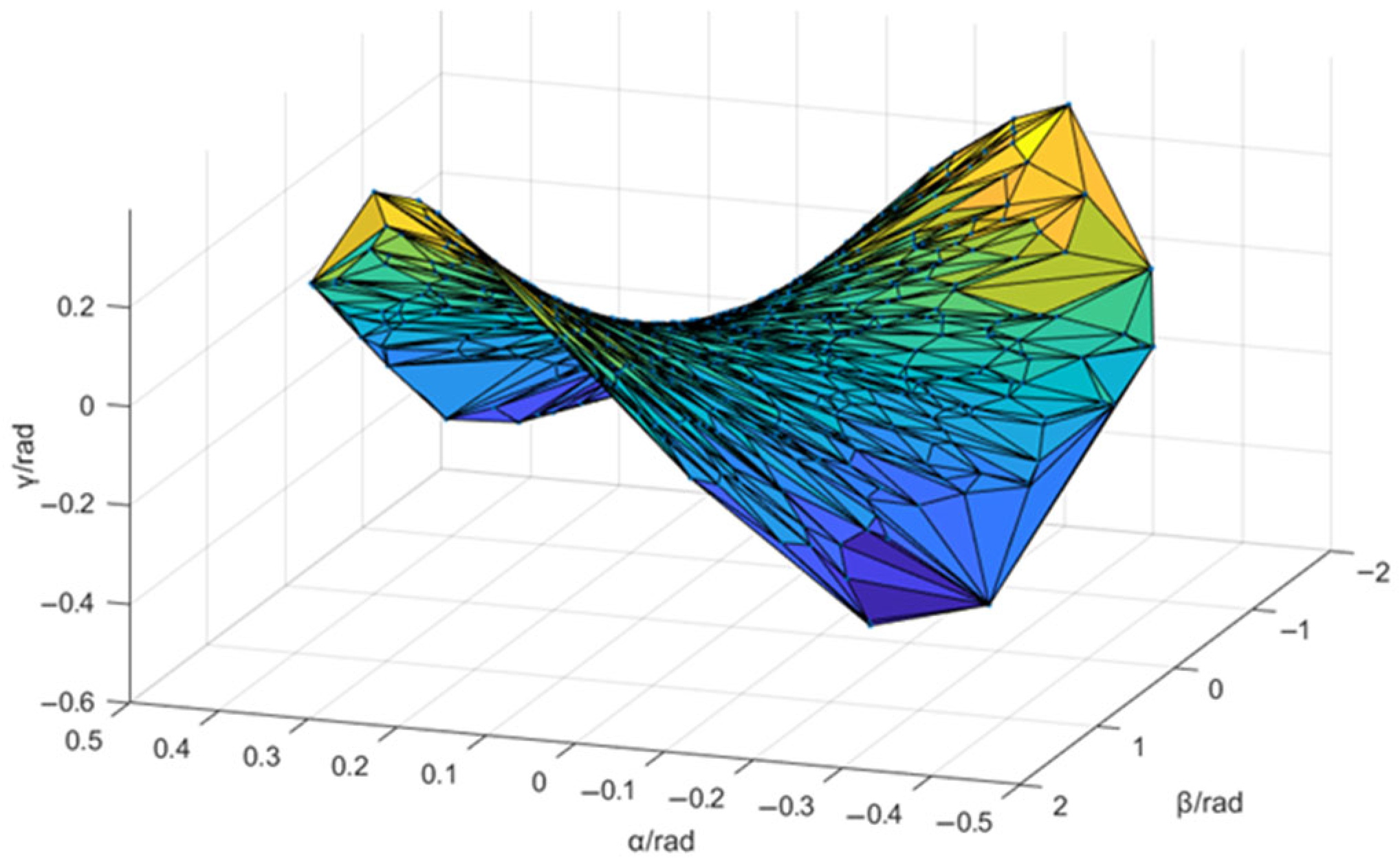

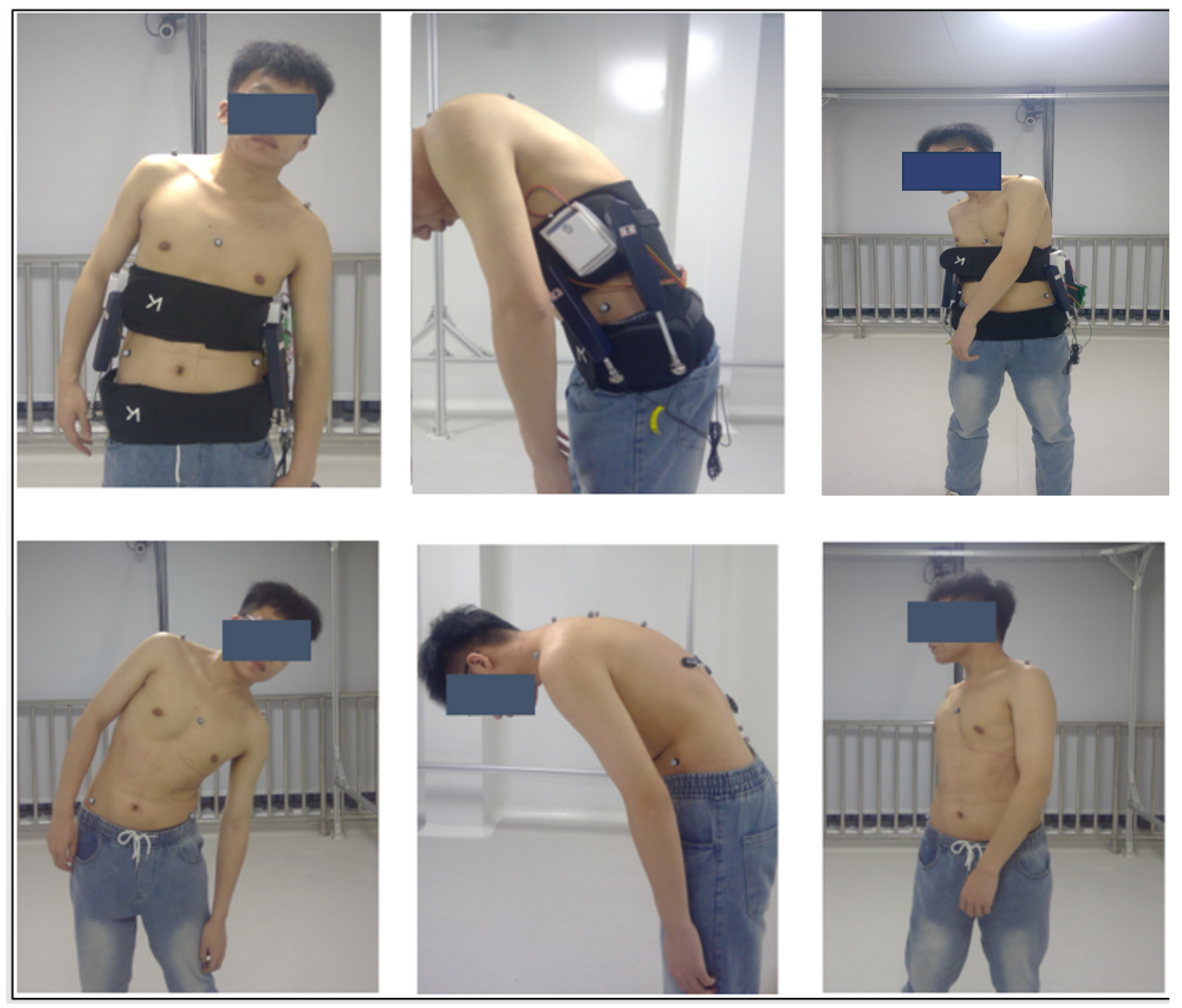
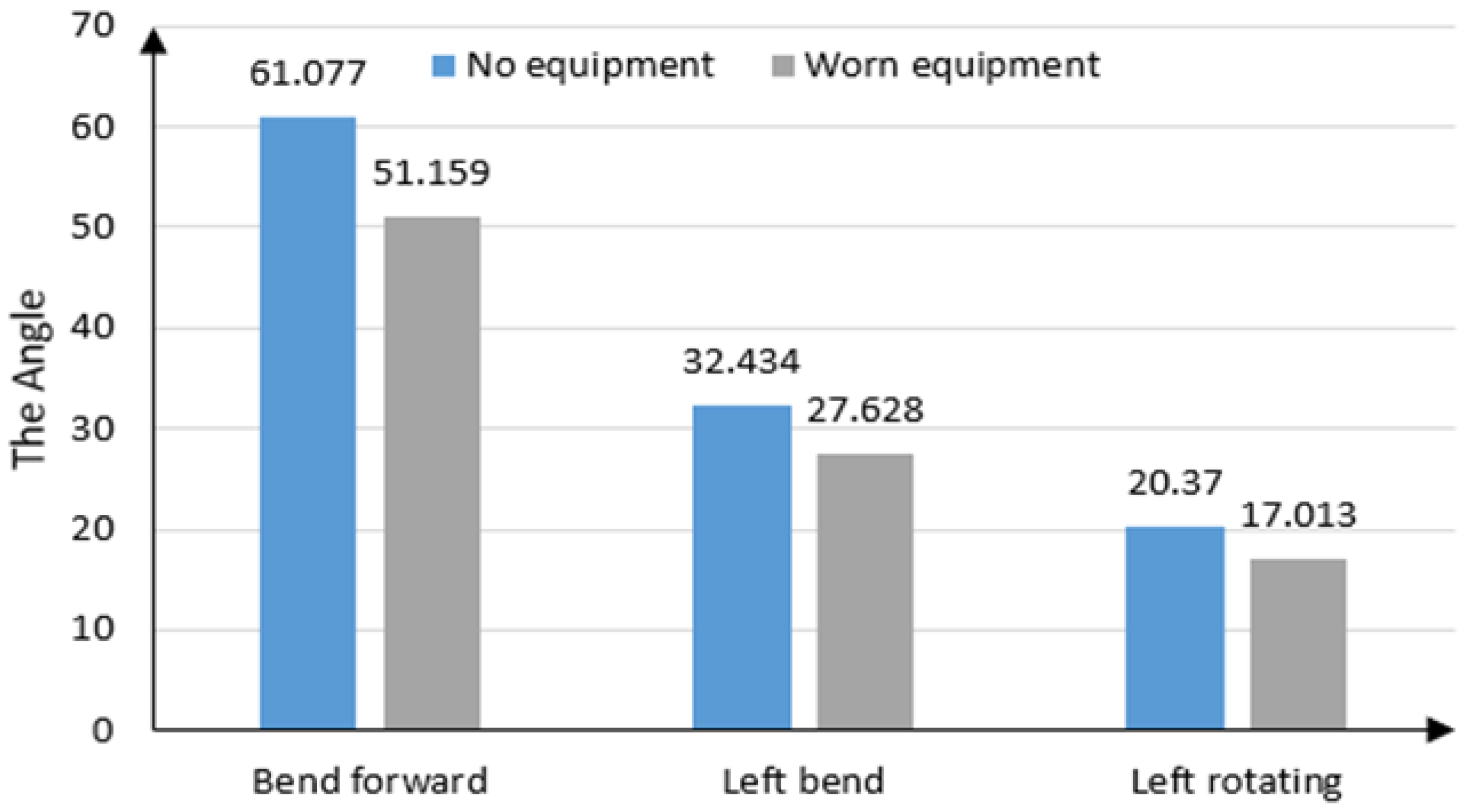
| Posture | Lumbar Disc Pressure (MPa) |
|---|---|
| lie flat | 0.1 |
| stand | 0.5 |
| bend forward | 1.1 |
| carrying a 20 kg load on one’s body | 1.1 |
| Geometric Parameter Description | Numerical Value |
|---|---|
| Set platform length | 380 mm |
| Set platform width | 80 mm |
| Mobile Platform Director | 360 mm |
| Moving platform width | 160 mm |
| Set the initial distance of the moving and Fixed platforms . | 240 mm |
| Parameters | Posture 1 | Posture 2 | Posture 3 | Posture 4 | |
|---|---|---|---|---|---|
| Known | (mm) | 240 | 240 | 240 | 240 |
| α | 0° | 5° | 10° | 20° | |
| (0.0873) | (0.1745) | (0.3491) | |||
| β | 0° | 10° | 20° | 40° | |
| (0.1745) | (0.3491) | (0.6981) | |||
| γ | 0° | 5° | 10° | 10° | |
| (0.0873) | (0.1745) | (0.3491) | |||
| solution | (mm) | 243.61 | 225.54 | 220.37 | 217.52 |
| (mm) | 243.61 | 258.36 | 264.38 | 278.69 | |
| (mm) | 243.61 | 260.27 | 270.26 | 283.23 | |
| (mm) | 243.61 | 234.95 | 222.39 | 219.58 |
| Parameters | Posture 1 | Posture 2 | Posture 3 | Posture 4 | |
|---|---|---|---|---|---|
| Known | (mm) | 243.61 | 225.54 | 220.37 | 217.52 |
| (mm) | 243.61 | 258.36 | 264.38 | 278.69 | |
| (mm) | 243.61 | 260.27 | 270.26 | 283.23 | |
| (mm) | 243.61 | 234.95 | 222.39 | 219.58 | |
| solution | (mm) | 240.52 | 240.49 | 240.56 | 240.30 |
| α | 0 | 0.0873 | 0.1745 | 0.3491 | |
| β | 0 | 0.1745 | 0.3491 | 0.6981 | |
| γ | 0 | 0.0873 | 0.1745 | 0.3491 |
| Movement of Test Subject | Measured Angle 1 | Measured Angle 2 | Measured Angle 3 | Average Value |
|---|---|---|---|---|
| Forward Flexion | 60.633 | 61.205 | 60.442 | 60.760 |
| Backward Extension | 15.226 | 14.835 | 15.758 | 15.273 |
| Left Lateral Flexion | 33.798 | 33.58 | 33.683 | 33.687 |
| Left Rotation | 19.385 | 19.876 | 19.425 | 19.562 |
| Movement of Test Subject | Without Equipment | With Equipment | ||||||
|---|---|---|---|---|---|---|---|---|
| Measured Angle 1 | Measured Angle 2 | Measured Angle 3 | Average Value | Measured Angle 1 | Measured Angle 2 | Measured Angle 3 | Average Value | |
| Forward Flexion | 59.633 | 61.778 | 61.822 | 61.077 | 50.854 | 51.232 | 51.391 | 51.159 |
| Left Lateral Flexion | 33.256 | 32.363 | 31.683 | 32.434 | 28.304 | 28.257 | 26.324 | 27.628 |
| Left Rotation | 19.748 | 20.876 | 20.486 | 20.370 | 16.933 | 16.974 | 17.132 | 17.013 |
Disclaimer/Publisher’s Note: The statements, opinions and data contained in all publications are solely those of the individual author(s) and contributor(s) and not of MDPI and/or the editor(s). MDPI and/or the editor(s) disclaim responsibility for any injury to people or property resulting from any ideas, methods, instructions or products referred to in the content. |
© 2025 by the authors. Licensee MDPI, Basel, Switzerland. This article is an open access article distributed under the terms and conditions of the Creative Commons Attribution (CC BY) license (https://creativecommons.org/licenses/by/4.0/).
Share and Cite
Hou, C.; Yin, Z.; Wu, D.; Qian, R.; Tian, Y.; Wang, H. Design and Kinematic and Dynamic Analysis Simulation of a Biomimetic Parallel Mechanism for Lumbar Rehabilitation Exoskeleton. Machines 2025, 13, 728. https://doi.org/10.3390/machines13080728
Hou C, Yin Z, Wu D, Qian R, Tian Y, Wang H. Design and Kinematic and Dynamic Analysis Simulation of a Biomimetic Parallel Mechanism for Lumbar Rehabilitation Exoskeleton. Machines. 2025; 13(8):728. https://doi.org/10.3390/machines13080728
Chicago/Turabian StyleHou, Chao, Zhicheng Yin, Di Wu, Rui Qian, Yu Tian, and Hongbo Wang. 2025. "Design and Kinematic and Dynamic Analysis Simulation of a Biomimetic Parallel Mechanism for Lumbar Rehabilitation Exoskeleton" Machines 13, no. 8: 728. https://doi.org/10.3390/machines13080728
APA StyleHou, C., Yin, Z., Wu, D., Qian, R., Tian, Y., & Wang, H. (2025). Design and Kinematic and Dynamic Analysis Simulation of a Biomimetic Parallel Mechanism for Lumbar Rehabilitation Exoskeleton. Machines, 13(8), 728. https://doi.org/10.3390/machines13080728





